Đặc điểm thành phần acid béo của một số nguyên liệu giàu chất béo và phi lê cá tra (Pangasianodon hypophthalmus) ở các giai đoạn phát triển
TÓM TẮT
Cá là nguồn thực phẩm cung cấp các acid béo thiết yếu, có giá trị cao và có ảnh hưởng tích cực đến
việc ngăn chặn các bệnh về tim mạch và hỗ trợ thần kinh. Nghiên cứu này được thực hiện nhằm
khảo sát thành phần acid béo của cá tra (Pangasianodon hypophthalmus) ở các giai đoạn phát triển
và một số các nguyên liệu giàu chất béo. Acid béo được phân tích và định lượng bằng phương pháp sắc
ký khí (GC/FID). Kết quả nghiên cứu cho thấy rằng đối với cá tra ở các giai đoạn phát triển, hàm lượng
SFA là cao nhất (42,14-45,56%), kế tiếp là MUFA (40,98-43,39%) và PUFA (12,64-16,77%). Phi lê cá
tra có chứa nhiều SFA (42,0-43,39% trong tổng hàm lượng các acid béo) và chứa rất ít hàm lượng PUFA
(13,64-17,65%), chứa chủ yếu là acid linoleic (44-59% trong tổng acid béo không bảo hòa đa). Cá tra
nuôi ở những vùng khác nhau có tổng hàm lượng PUFA n-3 trong phi lê khá thấp, chỉ từ 1,30 đến 2,23%.
Có sự khác biệt rõ rệt về thành phần các acid béo giữa các nguyên liệu dầu khảo sát. Acid palmitic
(C16:0; 19,41-37,4%), acid oleic (C18:1; 48,30-60,0%) và acid linoleic (C18:2; 54,01-54,7%) là những
acid béo có nhiều trong các loại dầu thực vật như dầu cám, dầu cọ, dầu mè, dầu cải, dầu hướng dương và
dầu đậu nành. Dầu cá hồi, dầu cá mòi và hạt lanh là những nguyên liệu chứa hàm lượng cao EPA trong
khoảng từ 2,66 đến 16,93% và DHA (3,3-7,27%), trong khi hạt lanh có hàm lượng α-linolenic cao đáng
kể (C18:3n-3; 21,9%). Kết quả khảo sát cho thấy các nguyên liệu giàu chất béo như dầu cá hồi, cá mòi
và hạt lanh chứa thành phần các acid béo thiết yếu omega-3 là nguồn nguyên liệu phù hợp trong sản xuất
thức ăn nâng cao hàm lượng các omega-3 và HUFA trong cơ thịt cá tra.
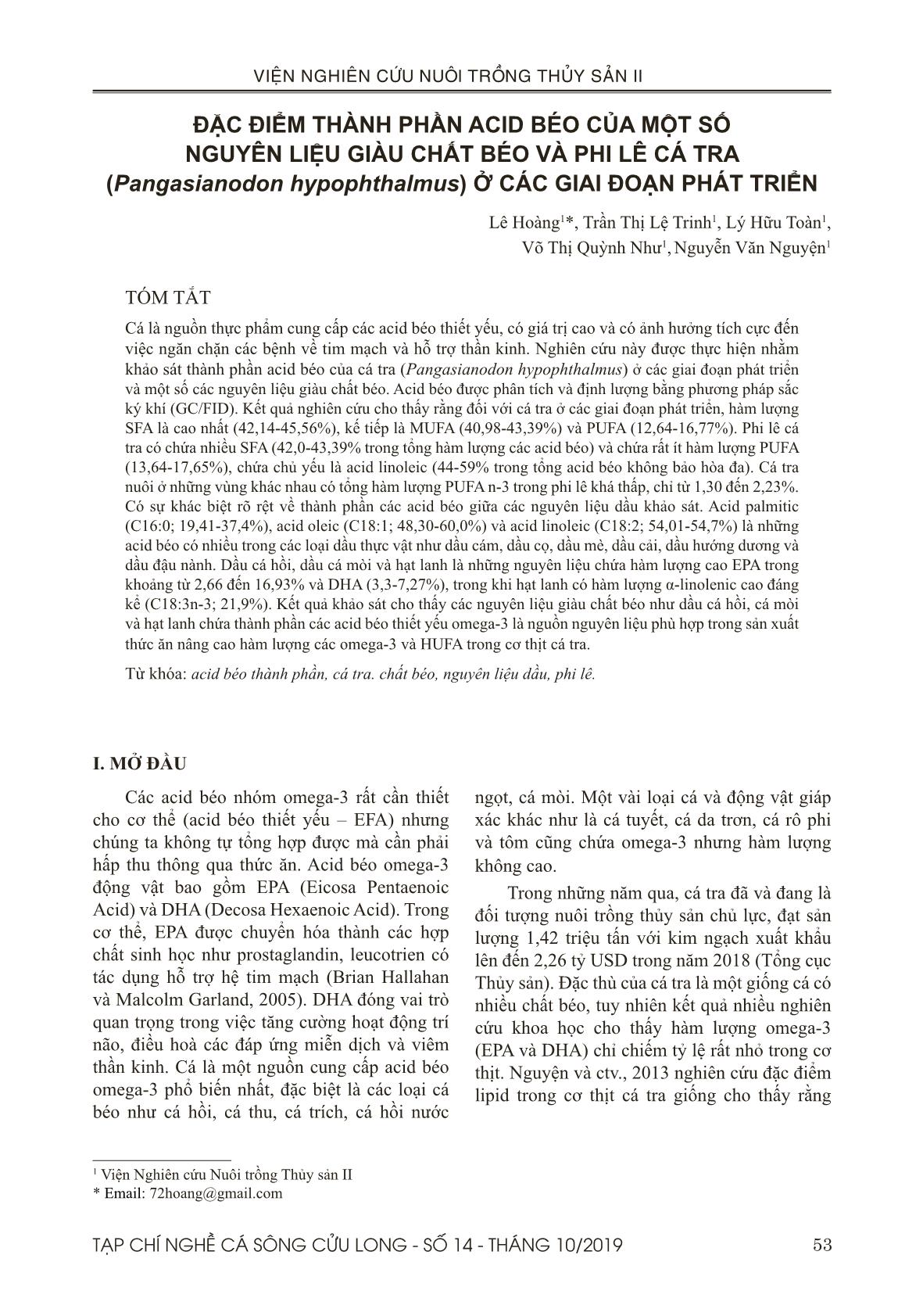
Trang 1

Trang 2
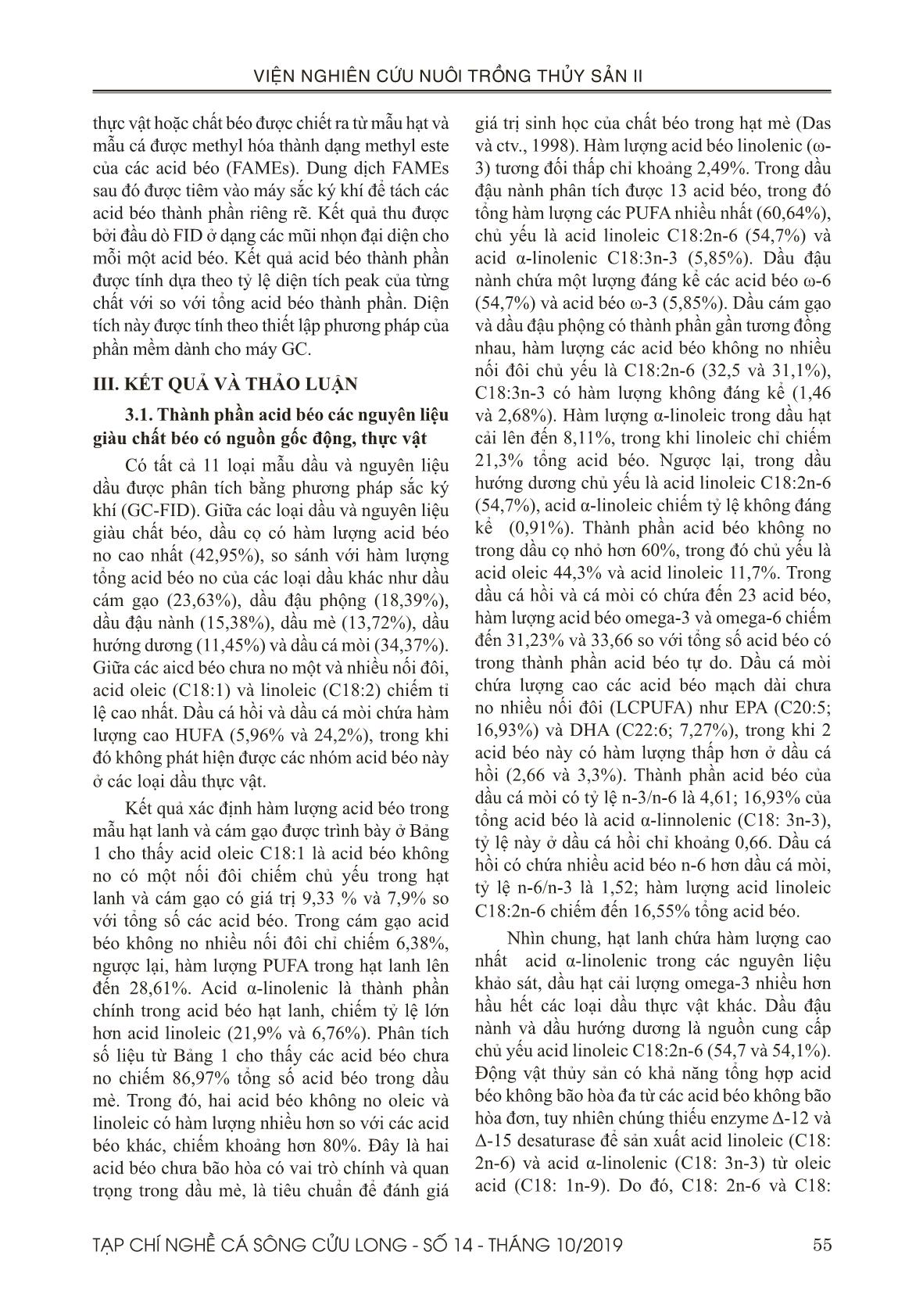
Trang 3
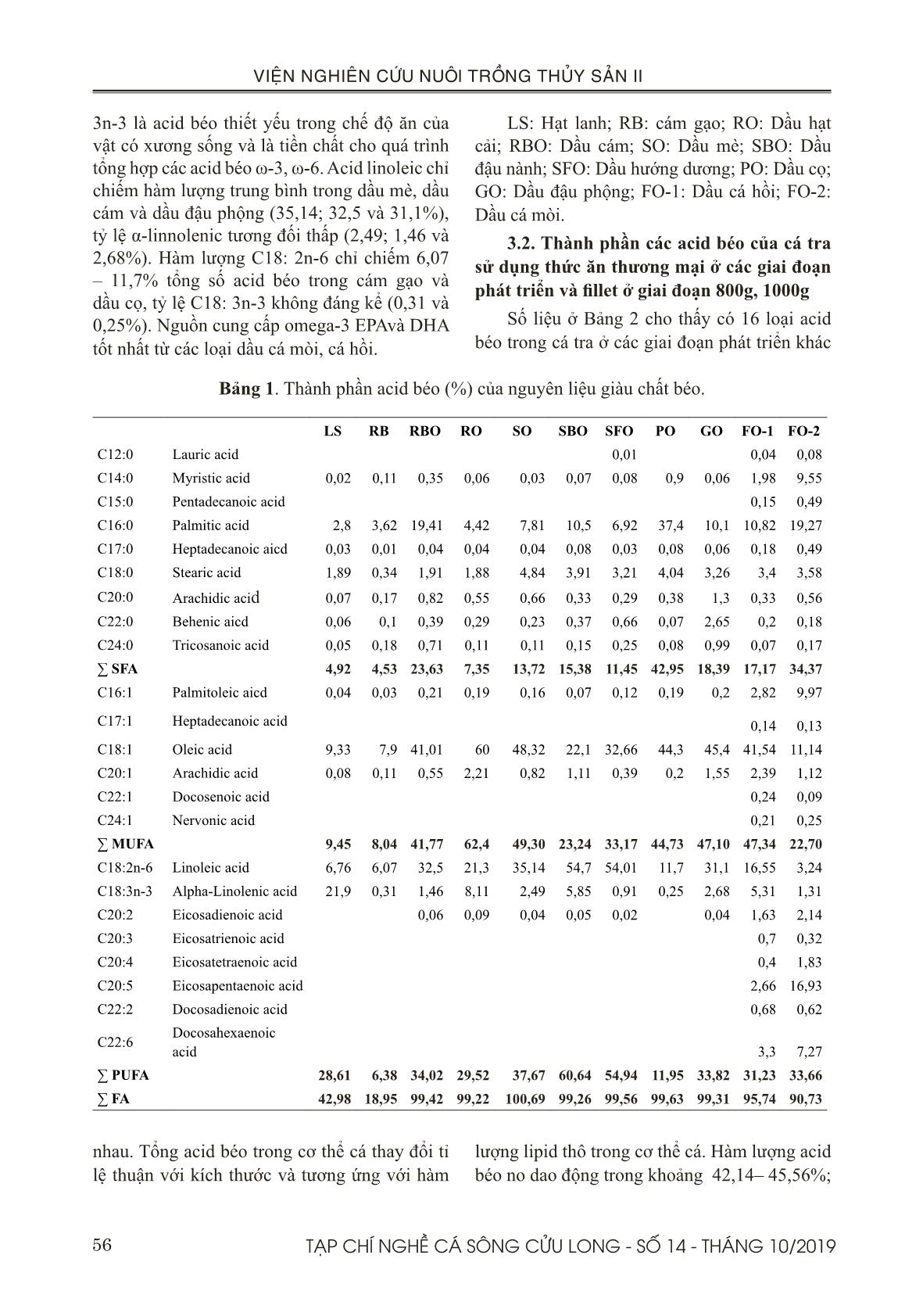
Trang 4

Trang 5
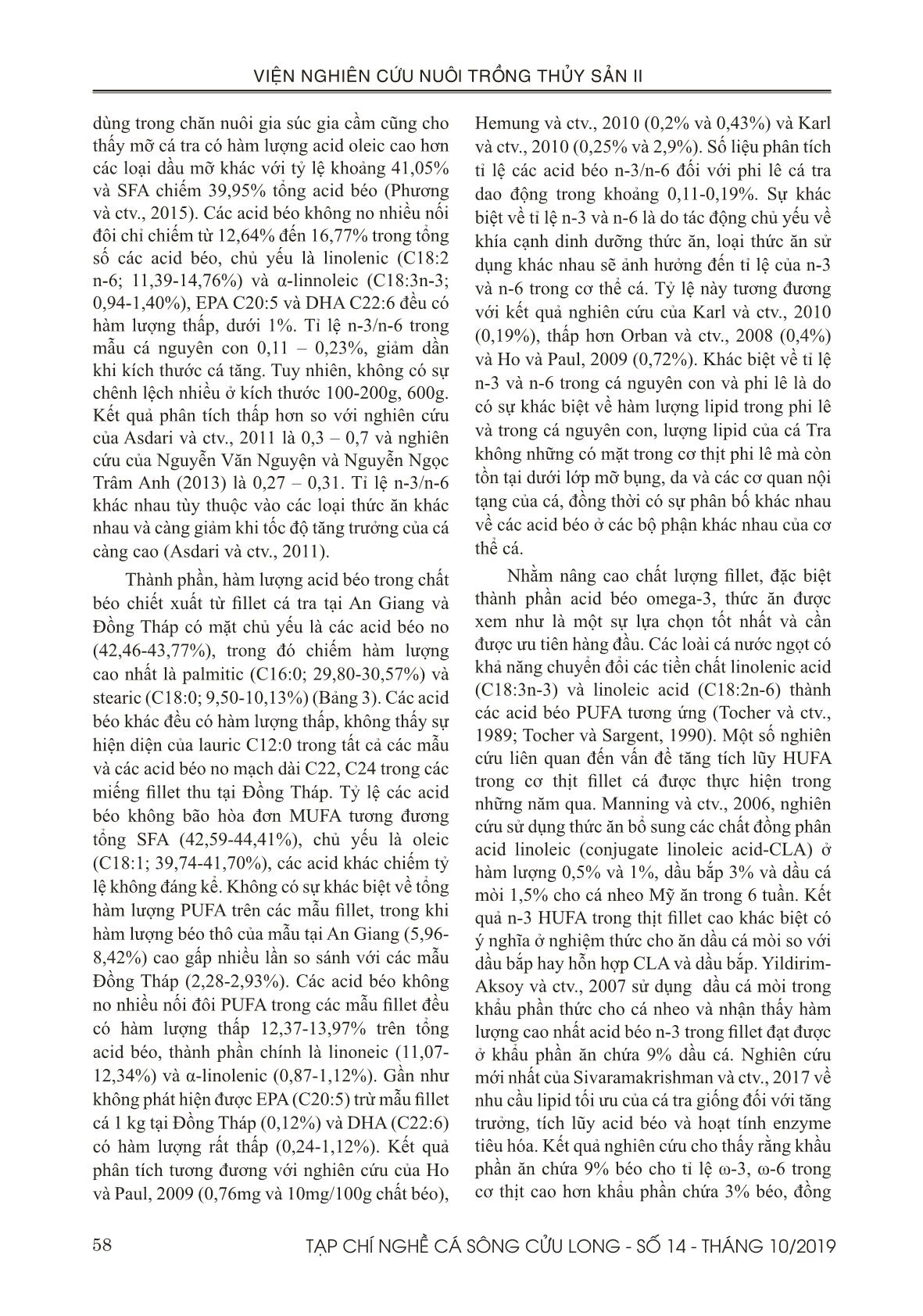
Trang 6
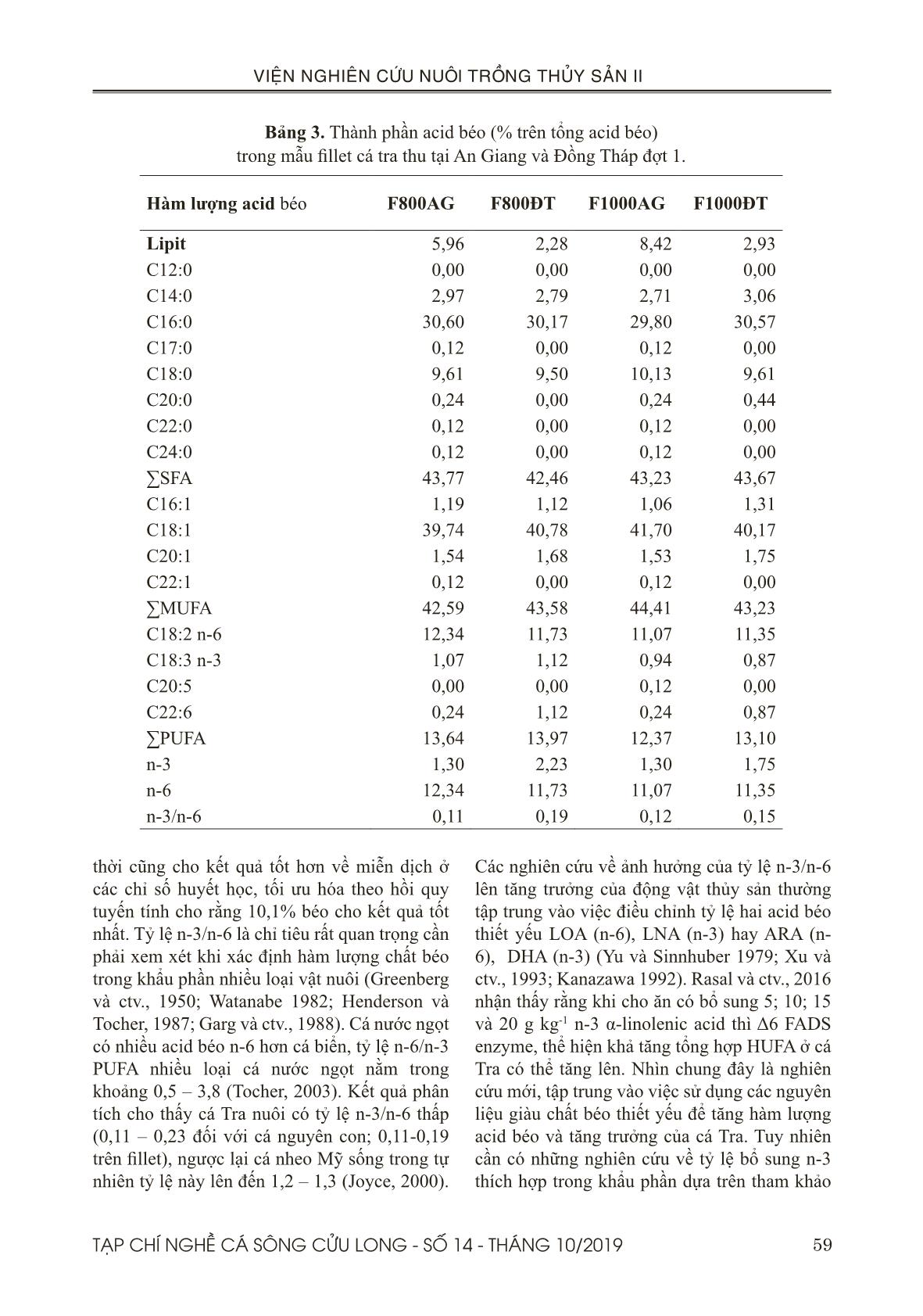
Trang 7
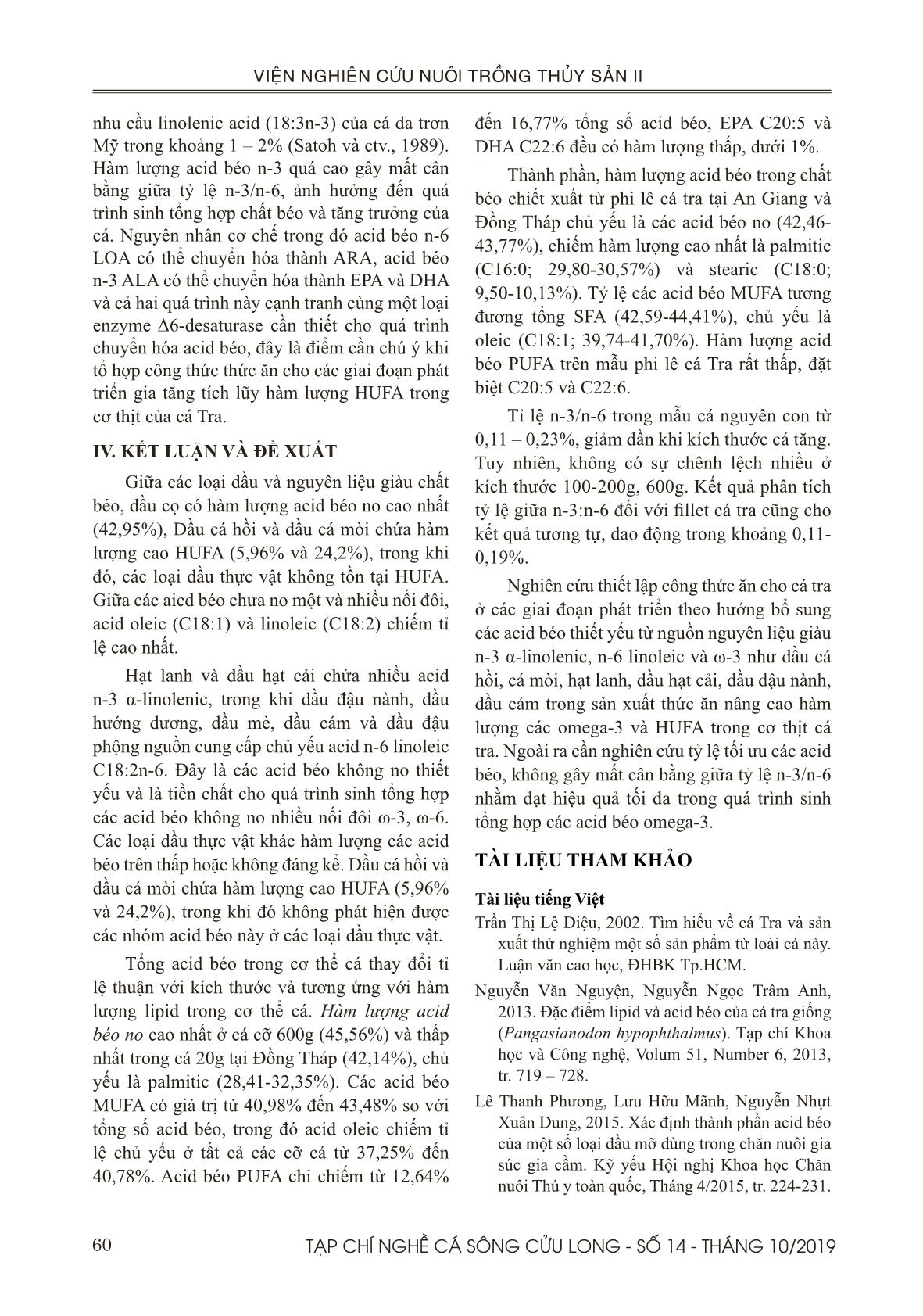
Trang 8
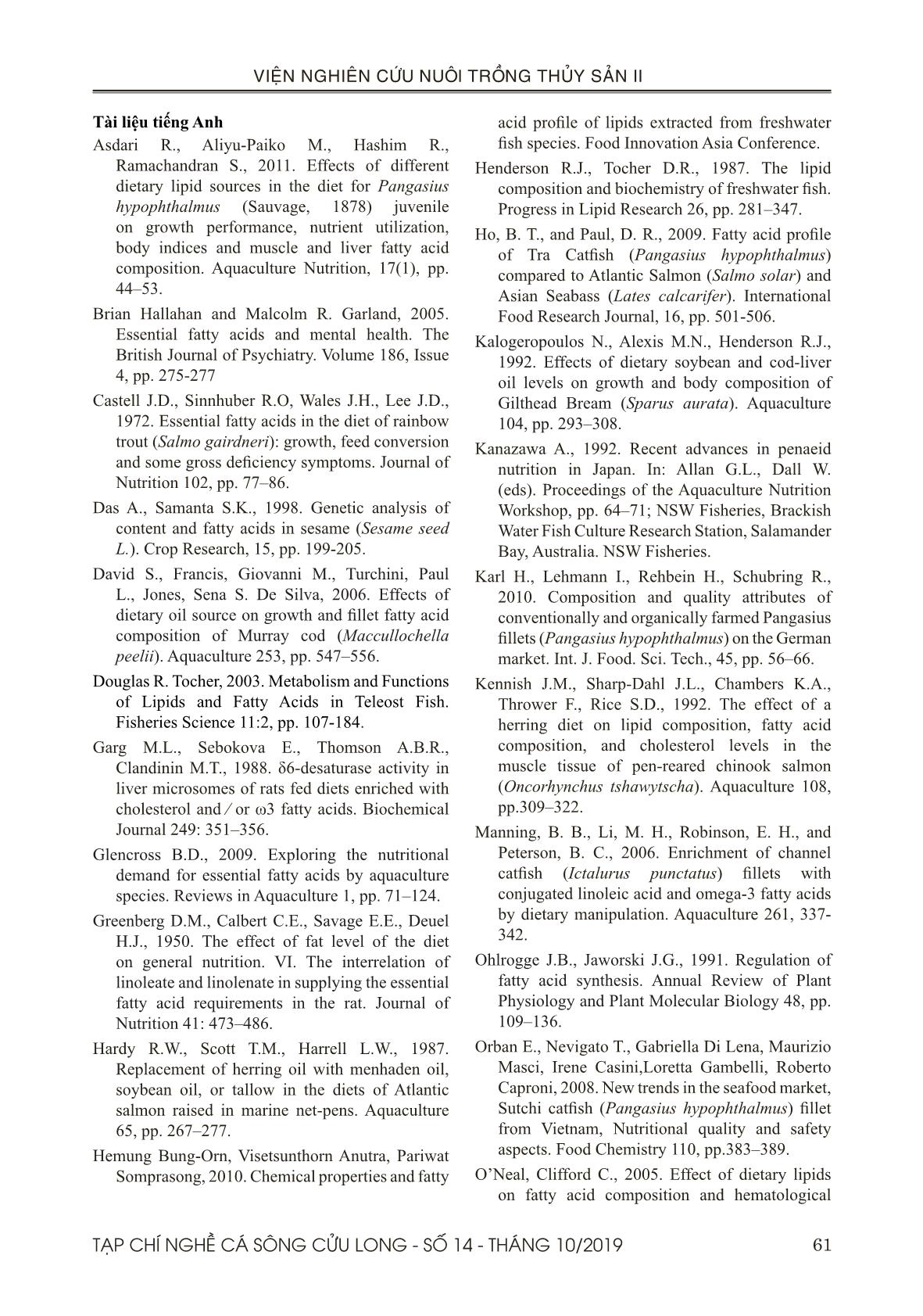
Trang 9
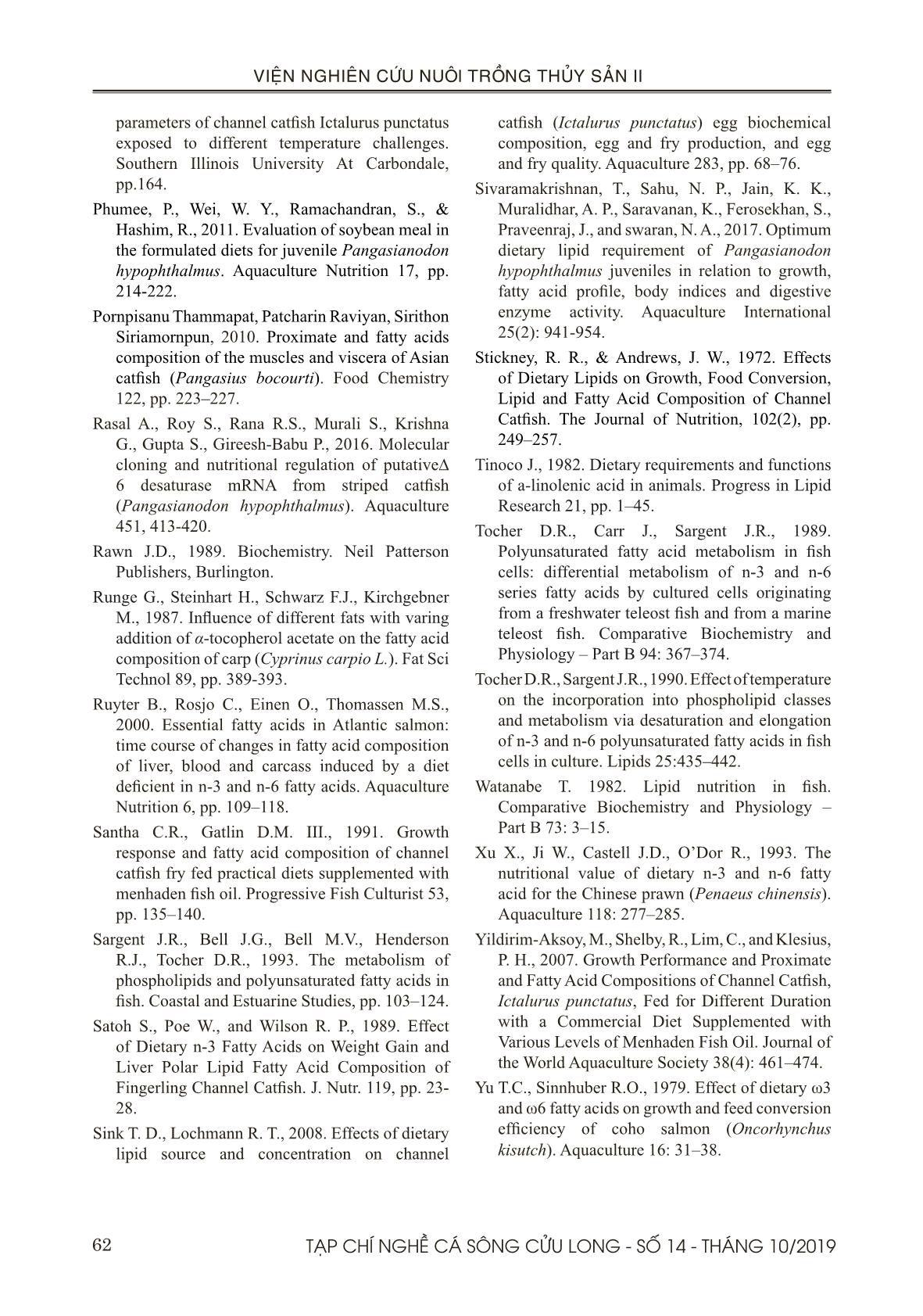
Trang 10
Tải về để xem bản đầy đủ
Tóm tắt nội dung tài liệu: Đặc điểm thành phần acid béo của một số nguyên liệu giàu chất béo và phi lê cá tra (Pangasianodon hypophthalmus) ở các giai đoạn phát triển
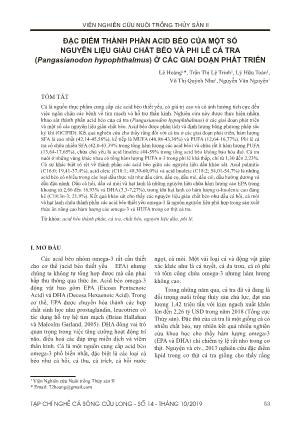
cid béo n-6 LOA có thể chuyển hóa thành ARA, acid béo n-3 ALA có thể chuyển hóa thành EPA và DHA và cả hai quá trình này cạnh tranh cùng một loại enzyme Δ6-desaturase cần thiết cho quá trình chuyển hóa acid béo, đây là điểm cần chú ý khi tổ hợp công thức thức ăn cho các giai đoạn phát triển gia tăng tích lũy hàm lượng HUFA trong cơ thịt của cá Tra. IV. KẾT LUẬN VÀ ĐỀ XUẤT Giữa các loại dầu và nguyên liệu giàu chất béo, dầu cọ có hàm lượng acid béo no cao nhất (42,95%), Dầu cá hồi và dầu cá mòi chứa hàm lượng cao HUFA (5,96% và 24,2%), trong khi đó, các loại dầu thực vật không tồn tại HUFA. Giữa các aicd béo chưa no một và nhiều nối đôi, acid oleic (C18:1) và linoleic (C18:2) chiếm tỉ lệ cao nhất. Hạt lanh và dầu hạt cải chứa nhiều acid n-3 α-linolenic, trong khi dầu đậu nành, dầu hướng dương, dầu mè, dầu cám và dầu đậu phộng nguồn cung cấp chủ yếu acid n-6 linoleic C18:2n-6. Đây là các acid béo không no thiết yếu và là tiền chất cho quá trình sinh tổng hợp các acid béo không no nhiều nối đôi ω-3, ω-6. Các loại dầu thực vật khác hàm lượng các acid béo trên thấp hoặc không đáng kể. Dầu cá hồi và dầu cá mòi chứa hàm lượng cao HUFA (5,96% và 24,2%), trong khi đó không phát hiện được các nhóm acid béo này ở các loại dầu thực vật. Tổng acid béo trong cơ thể cá thay đổi tỉ lệ thuận với kích thước và tương ứng với hàm lượng lipid trong cơ thể cá. Hàm lượng acid béo no cao nhất ở cá cỡ 600g (45,56%) và thấp nhất trong cá 20g tại Đồng Tháp (42,14%), chủ yếu là palmitic (28,41-32,35%). Các acid béo MUFA có giá trị từ 40,98% đến 43,48% so với tổng số acid béo, trong đó acid oleic chiếm tỉ lệ chủ yếu ở tất cả các cỡ cá từ 37,25% đến 40,78%. Acid béo PUFA chỉ chiếm từ 12,64% đến 16,77% tổng số acid béo, EPA C20:5 và DHA C22:6 đều có hàm lượng thấp, dưới 1%. Thành phần, hàm lượng acid béo trong chất béo chiết xuất từ phi lê cá tra tại An Giang và Đồng Tháp chủ yếu là các acid béo no (42,46- 43,77%), chiếm hàm lượng cao nhất là palmitic (C16:0; 29,80-30,57%) và stearic (C18:0; 9,50-10,13%). Tỷ lệ các acid béo MUFA tương đương tổng SFA (42,59-44,41%), chủ yếu là oleic (C18:1; 39,74-41,70%). Hàm lượng acid béo PUFA trên mẫu phi lê cá Tra rất thấp, đặt biệt C20:5 và C22:6. Tỉ lệ n-3/n-6 trong mẫu cá nguyên con từ 0,11 – 0,23%, giảm dần khi kích thước cá tăng. Tuy nhiên, không có sự chênh lệch nhiều ở kích thước 100-200g, 600g. Kết quả phân tích tỷ lệ giữa n-3:n-6 đối với fillet cá tra cũng cho kết quả tương tự, dao động trong khoảng 0,11- 0,19%. Nghiên cứu thiết lập công thức ăn cho cá tra ở các giai đoạn phát triển theo hướng bổ sung các acid béo thiết yếu từ nguồn nguyên liệu giàu n-3 α-linolenic, n-6 linoleic và ω-3 như dầu cá hồi, cá mòi, hạt lanh, dầu hạt cải, dầu đậu nành, dầu cám trong sản xuất thức ăn nâng cao hàm lượng các omega-3 và HUFA trong cơ thịt cá tra. Ngoài ra cần nghiên cứu tỷ lệ tối ưu các acid béo, không gây mất cân bằng giữa tỷ lệ n-3/n-6 nhằm đạt hiệu quả tối đa trong quá trình sinh tổng hợp các acid béo omega-3. TÀI LIỆU THAM KHẢO Tài liệu tiếng Việt Trần Thị Lệ Diệu, 2002. Tìm hiểu về cá Tra và sản xuất thử nghiệm một số sản phẩm từ loài cá này. Luận văn cao học, ĐHBK Tp.HCM. Nguyễn Văn Nguyện, Nguyễn Ngọc Trâm Anh, 2013. Đặc điểm lipid và acid béo của cá tra giống (Pangasianodon hypophthalmus). Tạp chí Khoa học và Công nghệ, Volum 51, Number 6, 2013, tr. 719 – 728. Lê Thanh Phương, Lưu Hữu Mãnh, Nguyễn Nhựt Xuân Dung, 2015. Xác định thành phần acid béo của một số loại dầu mỡ dùng trong chăn nuôi gia súc gia cầm. Kỹ yếu Hội nghị Khoa học Chăn nuôi Thú y toàn quốc, Tháng 4/2015, tr. 224-231. 61TẠP CHÍ NGHỀ CÁ SÔNG CỬU LONG - SỐ 14 - THÁNG 10/2019 VIỆN NGHIÊN CỨU NUÔI TRỒNG THỦY SẢN II Tài liệu tiếng Anh Asdari R., Aliyu-Paiko M., Hashim R., Ramachandran S., 2011. Effects of different dietary lipid sources in the diet for Pangasius hypophthalmus (Sauvage, 1878) juvenile on growth performance, nutrient utilization, body indices and muscle and liver fatty acid composition. Aquaculture Nutrition, 17(1), pp. 44–53. Brian Hallahan and Malcolm R. Garland, 2005. Essential fatty acids and mental health. The British Journal of Psychiatry. Volume 186, Issue 4, pp. 275-277 Castell J.D., Sinnhuber R.O, Wales J.H., Lee J.D., 1972. Essential fatty acids in the diet of rainbow trout (Salmo gairdneri): growth, feed conversion and some gross deficiency symptoms. Journal of Nutrition 102, pp. 77–86. Das A., Samanta S.K., 1998. Genetic analysis of content and fatty acids in sesame (Sesame seed L.). Crop Research, 15, pp. 199-205. David S., Francis, Giovanni M., Turchini, Paul L., Jones, Sena S. De Silva, 2006. Effects of dietary oil source on growth and fillet fatty acid composition of Murray cod (Maccullochella peelii). Aquaculture 253, pp. 547–556. Douglas R. Tocher, 2003. Metabolism and Functions of Lipids and Fatty Acids in Teleost Fish. Fisheries Science 11:2, pp. 107-184. Garg M.L., Sebokova E., Thomson A.B.R., Clandinin M.T., 1988. δ6-desaturase activity in liver microsomes of rats fed diets enriched with cholesterol and ⁄ or ω3 fatty acids. Biochemical Journal 249: 351–356. Glencross B.D., 2009. Exploring the nutritional demand for essential fatty acids by aquaculture species. Reviews in Aquaculture 1, pp. 71–124. Greenberg D.M., Calbert C.E., Savage E.E., Deuel H.J., 1950. The effect of fat level of the diet on general nutrition. VI. The interrelation of linoleate and linolenate in supplying the essential fatty acid requirements in the rat. Journal of Nutrition 41: 473–486. Hardy R.W., Scott T.M., Harrell L.W., 1987. Replacement of herring oil with menhaden oil, soybean oil, or tallow in the diets of Atlantic salmon raised in marine net-pens. Aquaculture 65, pp. 267–277. Hemung Bung-Orn, Visetsunthorn Anutra, Pariwat Somprasong, 2010. Chemical properties and fatty acid profile of lipids extracted from freshwater fish species. Food Innovation Asia Conference. Henderson R.J., Tocher D.R., 1987. The lipid composition and biochemistry of freshwater fish. Progress in Lipid Research 26, pp. 281–347. Ho, B. T., and Paul, D. R., 2009. Fatty acid profile of Tra Catfish (Pangasius hypophthalmus) compared to Atlantic Salmon (Salmo solar) and Asian Seabass (Lates calcarifer). International Food Research Journal, 16, pp. 501-506. Kalogeropoulos N., Alexis M.N., Henderson R.J., 1992. Effects of dietary soybean and cod-liver oil levels on growth and body composition of Gilthead Bream (Sparus aurata). Aquaculture 104, pp. 293–308. Kanazawa A., 1992. Recent advances in penaeid nutrition in Japan. In: Allan G.L., Dall W. (eds). Proceedings of the Aquaculture Nutrition Workshop, pp. 64–71; NSW Fisheries, Brackish Water Fish Culture Research Station, Salamander Bay, Australia. NSW Fisheries. Karl H., Lehmann I., Rehbein H., Schubring R., 2010. Composition and quality attributes of conventionally and organically farmed Pangasius fillets (Pangasius hypophthalmus) on the German market. Int. J. Food. Sci. Tech., 45, pp. 56–66. Kennish J.M., Sharp-Dahl J.L., Chambers K.A., Thrower F., Rice S.D., 1992. The effect of a herring diet on lipid composition, fatty acid composition, and cholesterol levels in the muscle tissue of pen-reared chinook salmon (Oncorhynchus tshawytscha). Aquaculture 108, pp.309–322. Manning, B. B., Li, M. H., Robinson, E. H., and Peterson, B. C., 2006. Enrichment of channel catfish (Ictalurus punctatus) fillets with conjugated linoleic acid and omega-3 fatty acids by dietary manipulation. Aquaculture 261, 337- 342. Ohlrogge J.B., Jaworski J.G., 1991. Regulation of fatty acid synthesis. Annual Review of Plant Physiology and Plant Molecular Biology 48, pp. 109–136. Orban E., Nevigato T., Gabriella Di Lena, Maurizio Masci, Irene Casini,Loretta Gambelli, Roberto Caproni, 2008. New trends in the seafood market, Sutchi catfish (Pangasius hypophthalmus) fillet from Vietnam, Nutritional quality and safety aspects. Food Chemistry 110, pp.383–389. O’Neal, Clifford C., 2005. Effect of dietary lipids on fatty acid composition and hematological 62 TẠP CHÍ NGHỀ CÁ SÔNG CỬU LONG - SỐ 14 - THÁNG 10/2019 VIỆN NGHIÊN CỨU NUÔI TRỒNG THỦY SẢN II parameters of channel catfish Ictalurus punctatus exposed to different temperature challenges. Southern Illinois University At Carbondale, pp.164. Phumee, P., Wei, W. Y., Ramachandran, S., & Hashim, R., 2011. Evaluation of soybean meal in the formulated diets for juvenile Pangasianodon hypophthalmus. Aquaculture Nutrition 17, pp. 214-222. Pornpisanu Thammapat, Patcharin Raviyan, Sirithon Siriamornpun, 2010. Proximate and fatty acids composition of the muscles and viscera of Asian catfish (Pangasius bocourti). Food Chemistry 122, pp. 223–227. Rasal A., Roy S., Rana R.S., Murali S., Krishna G., Gupta S., Gireesh-Babu P., 2016. Molecular cloning and nutritional regulation of putative∆ 6 desaturase mRNA from striped catfish (Pangasianodon hypophthalmus). Aquaculture 451, 413-420. Rawn J.D., 1989. Biochemistry. Neil Patterson Publishers, Burlington. Runge G., Steinhart H., Schwarz F.J., Kirchgebner M., 1987. Influence of different fats with varing addition of α-tocopherol acetate on the fatty acid composition of carp (Cyprinus carpio L.). Fat Sci Technol 89, pp. 389-393. Ruyter B., Rosjo C., Einen O., Thomassen M.S., 2000. Essential fatty acids in Atlantic salmon: time course of changes in fatty acid composition of liver, blood and carcass induced by a diet deficient in n-3 and n-6 fatty acids. Aquaculture Nutrition 6, pp. 109–118. Santha C.R., Gatlin D.M. III., 1991. Growth response and fatty acid composition of channel catfish fry fed practical diets supplemented with menhaden fish oil. Progressive Fish Culturist 53, pp. 135–140. Sargent J.R., Bell J.G., Bell M.V., Henderson R.J., Tocher D.R., 1993. The metabolism of phospholipids and polyunsaturated fatty acids in fish. Coastal and Estuarine Studies, pp. 103–124. Satoh S., Poe W., and Wilson R. P., 1989. Effect of Dietary n-3 Fatty Acids on Weight Gain and Liver Polar Lipid Fatty Acid Composition of Fingerling Channel Catfish. J. Nutr. 119, pp. 23- 28. Sink T. D., Lochmann R. T., 2008. Effects of dietary lipid source and concentration on channel catfish (Ictalurus punctatus) egg biochemical composition, egg and fry production, and egg and fry quality. Aquaculture 283, pp. 68–76. Sivaramakrishnan, T., Sahu, N. P., Jain, K. K., Muralidhar, A. P., Saravanan, K., Ferosekhan, S., Praveenraj, J., and swaran, N. A., 2017. Optimum dietary lipid requirement of Pangasianodon hypophthalmus juveniles in relation to growth, fatty acid profile, body indices and digestive enzyme activity. Aquaculture International 25(2): 941-954. Stickney, R. R., & Andrews, J. W., 1972. Effects of Dietary Lipids on Growth, Food Conversion, Lipid and Fatty Acid Composition of Channel Catfish. The Journal of Nutrition, 102(2), pp. 249–257. Tinoco J., 1982. Dietary requirements and functions of a-linolenic acid in animals. Progress in Lipid Research 21, pp. 1–45. Tocher D.R., Carr J., Sargent J.R., 1989. Polyunsaturated fatty acid metabolism in fish cells: differential metabolism of n-3 and n-6 series fatty acids by cultured cells originating from a freshwater teleost fish and from a marine teleost fish. Comparative Biochemistry and Physiology – Part B 94: 367–374. Tocher D.R., Sargent J.R., 1990. Effect of temperature on the incorporation into phospholipid classes and metabolism via desaturation and elongation of n-3 and n-6 polyunsaturated fatty acids in fish cells in culture. Lipids 25:435–442. Watanabe T. 1982. Lipid nutrition in fish. Comparative Biochemistry and Physiology – Part B 73: 3–15. Xu X., Ji W., Castell J.D., O’Dor R., 1993. The nutritional value of dietary n-3 and n-6 fatty acid for the Chinese prawn (Penaeus chinensis). Aquaculture 118: 277–285. Yildirim-Aksoy, M., Shelby, R., Lim, C., and Klesius, P. H., 2007. Growth Performance and Proximate and Fatty Acid Compositions of Channel Catfish, Ictalurus punctatus, Fed for Different Duration with a Commercial Diet Supplemented with Various Levels of Menhaden Fish Oil. Journal of the World Aquaculture Society 38(4): 461–474. Yu T.C., Sinnhuber R.O., 1979. Effect of dietary ω3 and ω6 fatty acids on growth and feed conversion efficiency of coho salmon (Oncorhynchus kisutch). Aquaculture 16: 31–38. 63TẠP CHÍ NGHỀ CÁ SÔNG CỬU LONG - SỐ 14 - THÁNG 10/2019 VIỆN NGHIÊN CỨU NUÔI TRỒNG THỦY SẢN II CHARACTERISTICS OF FATTY ACID COMPOSITION OF SEVERAL LIPID INGREDIENTS AND TRA CATFISH (Pangasius hypophthalmus) AT DIFFERENT DEVELOPMENTAL STAGES Le Hoang 1*, Tran Thi Le Trinh1, Ly Huu Toan1, Vo Thi Quynh Nhu1, Nguyen Van Nguyen1 ABSTRACT This study aimed to investigate the fatty acid composition of several lipid ingredients and striped catfish (Pangasianodon hypophthalmus) at various growth stages. Fatty acid profiles were analyzed using GC/FID. The results showed that short-chain fatty acids (SFA ) were the highest content (42.14–45.56%), followed by monounsaturated fatty acids, MUFA (40.98–43.48%), and polyunsaturated fatty acids, PUFA (12.64–16.77%). Commercial -size fillets contained high SFA (42.0–43.39%) and low PUFA (13.64–17.65%) which dominantly containing linoleic acid (44– 59%) in total PUFA. Total n-3 PUFA in fillets of different commercial sizes and farming regions was rather low and ranging from 1.30 to 2.23%. Remarkable differences of fatty acid profiles were characterized among the lipid ingredients. Palmitic acid (C16:0; 19.41–37.4%), oleic acid (C18:1; 48.30–60.0%) and linoleic acid (C18:2; 54.01–54.7%), respectively, were the dominant fatty acids in the certain vegetable oils such as rice bran oil, palm oil, sesame oil, rapeseed oil, sunflower oil, and soybean oil. High levels of EPA (2.66-16.93%) and DHA (3.3–7.27%) were observed in salmon oil and sardine oil, while flaxseed had a significantly higher content of alpha-linolenic acid (C18:3n-3; 21.9%). The studied results revealed that salmon oil, sardine oil, and flaxseed containing ω-3 fatty acids, are the appropriate lipid ingredients for feed manufacturing to enrich omega-3 and HUFA in striped catfish. Keywords: fatty acid profiles, fat-providing ingredients, fillet, lipid, tra catfish. Người phản biện: TS. La Xuân Thảo Ngày nhận bài: 18/9/2019 Ngày thông qua phản biện: 13/10/2019 Ngày duyệt đăng: 27/10/2019 Người phản biện: PGS.TS Ngô Hữu Toàn Ngày nhận bài: 25/9/2019 Ngày thông qua phản biện: 18/10/2019 Ngày duyệt đăng: 27/10/2019 Research Institute for Aquaculture No.2 *Email: 72hoang@gmail.com
File đính kèm:
 dac_diem_thanh_phan_acid_beo_cua_mot_so_nguyen_lieu_giau_cha.pdf
dac_diem_thanh_phan_acid_beo_cua_mot_so_nguyen_lieu_giau_cha.pdf

